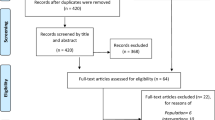Abstract
In this article, we examine the relationship between the total number of types of gambling that are legal in a state and the gambling involvement of state residents. Of particular interest is whether more types of legal gambling are associated with higher rates of problem gambling. Telephone surveys of U.S. adults were conducted in 1999–2000 and 2011–2013. The same questions were used and the data sets were combined for most of the analyses. Gambling exposure was defined as the sum of the number of years that all types were legal. Results tabulated by state showed progressively higher rates of problem gambling, frequent gambling and any past year gambling as the number of legal types of gambling increased. Holding constant the number of legal types, problem gambling rates increased as exposure increased. States with longer exposure to legal lotteries or casinos tended to have higher rates of problem gambling. An analysis was also conducted in which the data sets from 1999 to 2000 and from 2011 to 2013 were compared. Among the states, there was a striking positive relationship between changes in the number of legal types of gambling between the two studies and changes in rates of frequent gambling between the two studies. For states that had fewer types of legal gambling in 2011 than in 1999, the rates of frequent gambling went down. For states that increased their types of legal gambling, rates of frequent gambling typically, but not always, went up. Possible explanations for these results were discussed.
Similar content being viewed by others
References
Barron, J. M., Staten, M. E., & Wilshusen, S. M. (2002). The impact of casino gambling on personal bankruptcy filing rates. Contemporary Economic Policy, 20(4), 440–455.
Boardman, J. D., Finch, B. K., Ellison, C. G., Williams, D. R., & Jackson, J. S. (2001). Neighborhood disadvantage, stress, and drug use among adults. Journal of Health and Social Behavior, 42, 151–165.
Christian, J., Ladouceur, R., & Ferland, F. (2000). Impact of availability on gambling: A longitudinal study. The Canadian Journal of Psychiatry, La Revue canadienne de psychiatrie, 45(9), 810–815.
Cox, B. J., Yu, N., Afifi, T. O., & Ladouceur, R. (2005). A national survey of gambling problems in Canada. Canadian Journal of Psychiatry, 50(4), 213–217.
Delfabbro, P.H. (2002). The distribution of electronic gaming machines (EGMs) and gambling-related harm in metropolitan adelaide. Report commissioned by the independent gambling authority of South Australia.
Gerstein, D. R., Volberg, R. A., Toce, M. T., Harwood, H., Christiansen, E. M., Hoffman, J., et al. (1999). Gambling impact and behavior study: Report to the national gambling impact study commission. Chicago, Il: National Opinion Research Center at the University of Chicago.
Korn, E., & Graubard, B. (1999). Analysis of health surveys. Hoboken, NJ: Wiley.
LaPlante, D. A., & Shaffer, H. J. (2007). Understanding the influence of gambling opportunities: Expanding exposure models to include adaptation. American Journal of Orthopsychiatry, 77(4), 616–623.
Lavrakas, P. J. (1993). Telephone survey methods: Sampling, selection, and supervision. Newbury Park: Sage.
Lester, D. (1994). Access to gambling opportunities and compulsive gambling. Substance Use and Misuse, 29(12), 1611–1616.
McCleary, R., Chew, K. S. Y., Merrill, V., & Napolitano, C. (2002). Does legalized gambling elevate the risk of suicide? An analysis of U.S. counties and metropolitan areas. Suicide and Life-Threatening Behavior, 32(2), 209–221.
Robins, L., Marcus, L., Reich, W., Cunningham, R., & Gallagher, T. (1996). NIMH diagnostic interview schedule—Version IV (DIS-IV). St. Louis: Dept. of Psychiatry, Washington University School of Medicine.
Room, R. (1999). Community effects of the opening of the Niagara casino. Addiction, 94(10), 1449–1466.
Sévigny, S., Ladouceur, R., Jacques, C., & Cantinotti, M. (2008). Links between casino proximity and gambling participation, expenditure and pathology. Psychology of Addictive Behaviors, 22(2), 295–301.
Storer, J., Abbott, M., & Stubbs, J. (2009). Access or adaptation? A meta-analysis of surveys of problem gambling prevalence in Australia and New Zealand with respect to concentration of electronic gaming machines. International Gambling Studies, 9(3), 225–244.
Stricker, L. J. (1988). Measuring social status with occupational information: A simple method. Journal of Applied Social Psychology, 18(5), 423–437.
Tidwell, M.-C. O., Welte, J. W., Barnes, G. M., & Dayanim, B. (2015). Gambling modes and state gambling laws: Changes from 1999 to 2011 and beyond. Gaming Law Review and Economics, 19(1), 13–26.
Volberg, R. A. (1994). The prevalence and demographics of pathological gamblers: Implications for public health. American Journal of Public Health, 84(2), 237–241.
Welte, J. W., Barnes, G. M., Tidwell, M-C., & Hoffman, J. H. & Wieczorek, W. F. (2014). Gambling and problem gambling in the United States: Changes between 1999 and 2013. Journal of Gambling Studies.
Welte, J. W., Barnes, G. M., Tidwell, M.-C., & Hoffman, J. H. (2009). Legal gambling availability and problem gambling among adolescents and young adults. International Gambling Studies, 9(2), 89–99.
Welte, J. W., Wieczorek, W. F., Barnes, G. M., Tidwell, M.-C., & Hoffman, J. H. (2004). The relationship of ecological and geographic factors to gambling behavior and pathology. Journal of Gambling Studies, 20(4), 405–423.
Acknowledgments
This research was funded by the National Institute on Alcohol Abuse and Alcoholism Grants AA11402 and AA018097, awarded to John W. Welte.
Conflict of interest
The authors declare that they have no conflict of interest.
Author information
Authors and Affiliations
Corresponding author
Rights and permissions
About this article
Cite this article
Welte, J.W., Tidwell, MC.O., Barnes, G.M. et al. The Relationship Between the Number of Types of Legal Gambling and the Rates of Gambling Behaviors and Problems Across U.S. States. J Gambl Stud 32, 379–390 (2016). https://doi.org/10.1007/s10899-015-9551-0
Published:
Issue Date:
DOI: https://doi.org/10.1007/s10899-015-9551-0




